A friend offered me what I thought was a wax ball.
"What, you've never eaten rice cake before?" he responded, incredulously.
- 餅(もち)
- sticky rice cake
At first glance, calling the white ball a "cake" seemed like a stretch. It wasn't fluffy and had no frosting or cream. And yet, as I took my first bite, the soft texture both impressed and confused me. I wanted more.
"In Japan we call it mochi," my friend said with a smile. I had never tasted or seen anything like mochi 餅. What was this ball made of? How did it get its gooey texture? I wanted answers. Delicious, delicious answers.
From here, I began my mochi quest, searching Japan for the most delectable treats, as well as information on what makes Japanese rice cakes different from the "mochi ice cream" you find at Trader Joe's. What I found was surprising.
- What is Mochi?
- Mochi History and Culture
- How to Make Mochi
- Variations
- ‘Tis the Season for Mochi
- Mochi Recipes
- Best Places to Get Mochi in Japan
- Mochi's Secret Ingedient
What is Mochi?
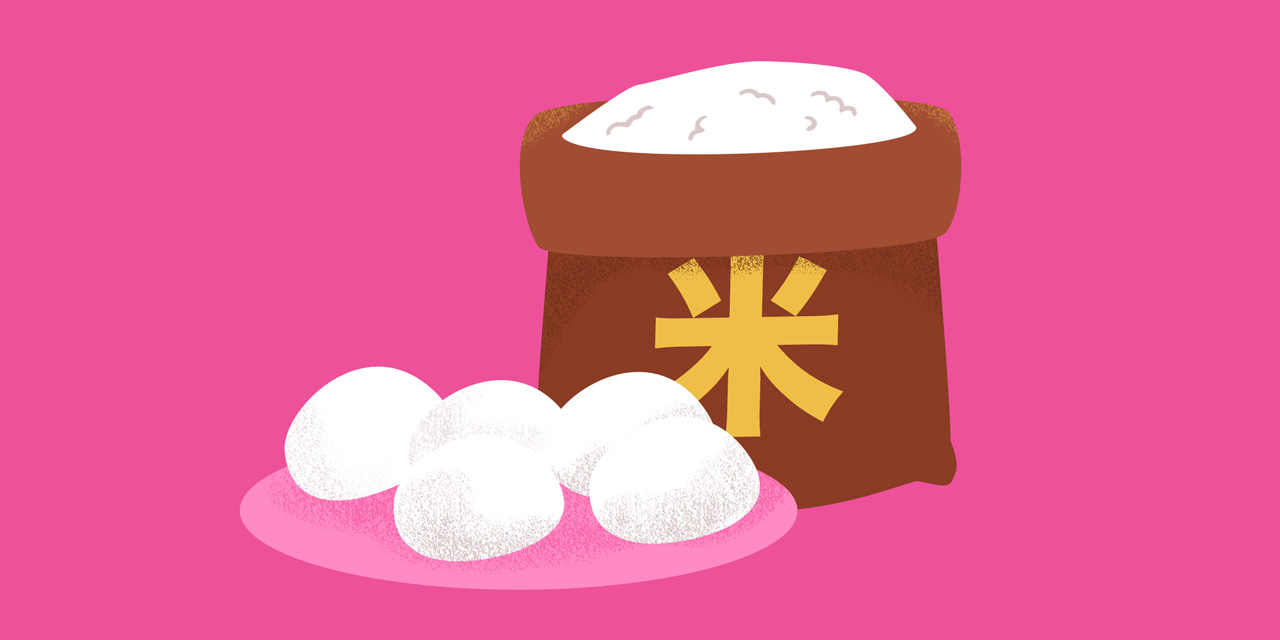
Mochi can be difficult to define because it takes so many forms. Sometimes it's hard as a rock, sometimes it's soft and gooey. Before we proceed, let's take a moment to break down the essential elements of the Japanese rice cake, because, as you'll see, there are some imitators.
Mochi Ingredients
1. Mochigome Rice
Mochi's gooey texture sets it apart from other sweets. But what gives it that unique, delicious consistency?
The answer lies in its main ingredient: the rice. But mochi rice isn't your average, everyday grain. No, it's a special short grain glutinous mochigome もち米 rice.
Technically speaking rice is made of two starches:
- Amylose
- Amylopectin
Amylose is less soluble in water and as a result is less sticky when cooked. Long grain, Western rice is high in amylose.
In contrast, amylopectin is highly soluble and sticky when cooked. Medium grain rice contains more amylopectin than long grain, which gives it a creamier texture. Short grain, glutinous rice "contains the highest amount of amylopectin and no amylose," and becomes sticky or gelatinous when boiled and doughy when steamed.
Put simply, short grain Japanese mochigome rice has a special carbohydrate which gives it a gooey texture and makes it prime for pounding into gelatinous balls of mochi.
2. Water and Air
Mochi's ingredients are so simple it's downright impressive. Mochigome rice is steamed and then processed by repeated smashing by traditional hammers or modern machines. Pounding turns the rice into a dough while adding vital, yet easy-to-miss ingredients: water and air.
Adding water prevents the mochi from sticking to the mallets, machines, or hands that come in contact with it. Water makes mochi a clean food, devoid of powders, oils, or unnatural additives.
Pounding adds air bubbles to the mochi which contributes to its gooey, stretchy texture. The most delicious mochi I've ever tasted was less dense, more stretchy, and easier to eat thanks to the air bubbles added through the hammering process.
3. Ball Shape
- もち米(もちごめ)
- glutinous rice
Pounding combines rice grains into a giant ball of dough that lends itself to a variety of flavors and styles (more on that later). A watermelon-sized clump of mochi is divided into single-serving, palm-sized balls then rolled in flour, starch, or kinako powder to prevent sticking. Other times, the mass of mochi is made into large blocks and sealed in plastic wrap for easy storage. Though mochi takes many forms in the end, it always begins life as a ball.
Mochi vs. Dango vs. Fake Mochi
Unlike mochi, dango is made from dried rice flour, not mochigome rice. The use of this dried rice flour gives dango more in common with Western cakes than it does with mochi. Also, dango can be made by hand, rendering hammers and steamers unnecessary. The small dango balls are rolled in kinako or sweet syrups before getting skewered on sticks
In a pinch, "mochi" (or as I like to call it, fake mochi) can be made from flour as this recipe calls for. But is it really mochi? I'm not a connoisseur and even I notice subtle differences. Flour-made mochi is less stretchy and chewy than the real thing. They also fall apart if cooked in soup. By skipping the kneading process, air bubbles are never formed, making this "flour mochi" fundamentally different in components, flavor, and texture.
Mochi Nutrition Facts
Every winter I hear the mochi lover's lament: "I gained 6 pounds. I just couldn't stop eating mochi!"
Mochi's super-dense rice concentration means one average-sized cake (which fits in the palm of your hand) packs a deceptive amount of calories. Many friends and colleagues have told me that one small ball of mochi has the calorie-equivalent of a full bowl of rice.
Research into this claim proved it to be false, however. One bowl of rice has about 240 calories. A ball of mochi has about 80 calories, one-third of a rice bowl. Though my friend's claim wasn't scientifically accurate, the wisdom is still there: eating mochi can add up. It's easy to eat and at 80 calories a pop you might find yourself overeating without even realizing it.
Mochi History and Culture

Mochi has a long cultural history in Japan, but the details are sticky. While we don't know the exact date Japanese rice cakes were invented, archeologists have unearthed steaming tools, similar to those used in making mochi, which date all the way back to the Kofun Period.
While the when of mochi may be fuzzy, scholars do know the where. Mochi has historical roots in Western Japan thanks to the area's farming methods. In ancient times, Eastern Japan developed slash and burn farming techniques that fostered a diet of taro and yams. At the same time, Western Japan was dependent on rice agriculture and so the tradition of eating mochi on New Year's probably started there.
Mochi has historical roots in Western Japan thanks to the area's farming methods.
Rice cultivation became so important to Japanese culture, that the crop took on religious significance. In Shinto, people prayed for and thanked rice gods for successful harvests.
Ancient tales, like one from the 8th century book, "Bungoku Fudoki," offer insight into Japan's spiritual respect for rice. Once upon a time, a wealthy family used the season's extra rice crop to make rice cakes. But instead of eating the cakes, they used them as targets for archery practice, which was a wasteful, disrespectful act they'd regret. In a form of divine retribution, the remnants of the shot-up mochi transformed into white birds that flew away. From then on their rice fields lay bare and the family fell into ruin. As a result, swans came to symbolize rice cultivation and good luck. And by the way, wasting rice is still considered a great sin in Japan today.
Kagami Mochi and New Year's
Japan's most visual mochi tradition, kagami mochi 鏡餅, is a New Year's decoration made using two big mochi cakes. In a snowman like set-up, a giant mochi cake forms the base, with a smaller mochi cake in the middle and a daidai citrus fruit on top.
Display styles range from simple to elaborate. Sometimes a sheet of konbu seaweed and dried persimmon are placed under the mochi. The entire display can be placed on a sanpou 三宝 stand on a sheet called a shihoubeni 四方紅. Fern leaves and shide 紙垂 may also be attached.
With origins in the Kamakura Period, Kagami mochi is shiny and round, representing a mirror. Many theories exist to explain its importance. For example, mochi represents the spirit or soul of rice. The Japan times elaborates:
Kagami mochi, made of rice harvested in fall of the same year, is thought to contain the pure spirit of rice and thus be possessed with toshigami, a deity that is said to visit during the New Year's period, bringing a good harvest and the blessing of ancestors, and the power of life, according to the Japan Kagami Mochi Association.
Kagami mochi is so iconic, you could say it's the Japanese New Year's "Christmas Tree," in terms of symbolism.
Mochi is also said to give strength to those eating it. The use of two mochi symbolizes the passage of time, one for the previous year and one for the new year. They may also represent the moon and the sun or have a yin and yang type meaning. The fruit on top symbolizes the family line. The name of the bitter orange daidai 橙 has the same pronunciation as daidai 代々, which means "generations" in Japanese.
Kagami mochi is displayed in the tokonoma 床の間 alcove or on a kamidana, a special place for worship in the Japanese home. After a little more than a week of observance, families eat the mochi during the Kagami Biraki 鏡開き, or mochi-breaking ceremony, that usually takes place on January 11th.
Rabbits, Mochi, and the Moon
Japan's most famous mochi can be found on the moon. Konjaku Monogatari 今昔物語 (An Anthology of Tales from the Past), a collection of tales dating back to the Heian Period, tells of a rabbit that sacrifices itself for an old man. Typical of Japanese folklore, the old man reveals himself to be a deity and celebrates the rabbit's virtue by etching its image on the moon for all to see.
The story is a variant of one of India's ancient Jataka Tales, an influential collection whose popularity throughout Asia explains why many countries in the region see a rabbit when gazing at the moon.
Soul Food (Literally)
Mochi isn't merely a food, it's home to inadama 稲魂, which is, literally, the soul or spirit that dwells within rice.
As a society that depended on rice harvests, Japan gained a deep respect for rice and its spirit. Ancient Shinto rituals celebrated the rice spirit's arrival and successful harvests with prayers and offerings. Japanese people believe mochi's inadama can revive and reenergize those who eat it. As such, mochi became a food for special occasions, like New Year's and Children's Day.
How to Make Mochi

By now, I bet your stomach is rumbling, ready to partake in some sweet rice cakes (and all the spirits that come along with it). You could go to the store and buy some, but for special days you have to make it yourself. There's more than one way to pound rice, but if you want to have a traditional mochitsuki 餅搗き experience, you need to get yourself a giant hammer.
Below I've layed out the exact tools you need and step-by-step instructions for making mochi the traditional way.
Tools
- Kine 杵: These traditional, sledgehammer-sized wooden mallets must be soaked in a bucket of water the night before mochitsuki. Soaking helps prevent rice from sticking to the mallet.
- Usu 臼: This is the bowl-shaped wood or stone mortar you put the rice into before pounding. A coarse brush may be used to remove any dried remains from the previous usage. It's then filled with water and left to sit overnight. When it's time to make mochi, the usu is placed on a wooden pedestal and heated with warm water. Once heated, the water is dumped out and replaced with steamed rice.
- Usudai 臼台: This is the usu pedestal, which is made of thick boards. The usu is placed on top of it, so it has to be strong enough to withstand the usu's weight and the kine's pounding.
Preparation
First, the mochigome rice is soaked in water. Timing is key. Once the rice is soaked, it has to be pounded soon after. For this reason, the mochi show must go on the next day, rain or shine!
You know the rice is ready when it's soft enough for a chopstick to cut through.
In the morning, the soaked rice is placed in a wooden box lined with fabric netting. The netting prevents the rice from sticking to the box and makes removal easier. The wooden box is placed on a pot of water, which is then heated with a giant kerosene flame. Steam rises up through a hole in the box and cooks the rice. At every mochi making party I've been to, three to seven wooden boxes full of rice are stacked on top of the pot, all cooking at the same time. The bottom box gets the greatest concentration of the steam, cooking faster than those above it.
How do you know the rice is ready? According to the experienced men and women I've worked with, it should be soft enough for a chopstick to cut through. Cook it too little and the rice won't bind into a dough. Cook it too long and it becomes a mushy mess.
Once the rice has cooked, it is placed in the usu. Before the pounding can begin, the rice is massaged with the kine until it's combined into a single ball. Rice grains may still be visible, but all grains must be smooshed firmly into the mochi mass.
Now, let the pounding begin! It's best to start slow to prevent rice from bursting out of the usu on impact. Once the rice is kneaded into a white ball, the kine can be swung with more force. Pounding continues until any semblance of rice disappears and only one giant mochi ball remains.
Mochitsuki
Traditional mochi making requires a group of people with kine and a handler. Although the kine looks most important, the handler takes the central, most dangerous role, wetting their hands and handling the mochi between strikes. Water prevents the mochi from sticking to the mallet and allows the mochitsuki to gain a consistent rhythm. The handler flips the ball around, preventing it from sticking to the usu or kine and ensuring it gets pounded consistently throughout.
But the handler also risks injury. Their hands can get smashed if the hammer wielding team loses focus. Rhythm is vital to good mochi making. An established rhythm means smooth, continuous handling and pounding from start to finish. It also means less chance of broken hands.
Variations

- 大福(だいふく)
- rice cake stuffed with filling, often anko
The process described above makes plain, white mochi. But real masters of rice cake cuisine can get creative with mochi flavors, fillings, and extra ingredients.
At one mochi party I attended, we added spinach to a batch of mochigome, and at another we added chocolate. Any additions get pounded into the rice, leading to a complex flavor.
Here are a few popular varieties you're bound to run into:
- Daifuku 大福: These mochi cakes are filled with delicious ingredients, often anko.
- Kusa Mochi 草餅: Translated as "grass mochi," Japanese mugwort is added to the mochigome base to give this mochi it's green texture and leafy flavor.
- Botamochi 牡丹餅: While daifuku fills mochi with other ingredients, botamochi is the other way around: mochi is the filling inside other ingredients. Classic botamochi uses a firm azuki paste packed around a small ball of rice cake.
- Hanabiramochi 花びら餅: In this confection, mochi is flattened like a pancake, then folded over anko and a small piece of burdock root.
- Kuzumochi 葛餅: Made from kudzu plant starch which gives it a translucent shade of white, kuzumochi is often served chilled with molasses or black sugar syrup.
- Oshiruko お汁粉/Zenzai 善哉: This soup uses sweet azuki bean as a base, either creating a consistent watery soup or chunky texture, depending on how the beans are crushed. Western Japan uses a combination of both paste and crushed beans. Although the soup can be enjoyed as is, mochi can be added to the bowl. The hot soup makes it delectably warm, soft, stretchy, and chewy.
- Sakura Mochi 桜餅: In the Kanto area, sakura mochi is a crepe-like rice cake filled with anko. In Kansai, it's a round cake filled with the sweet bean paste. Both have a pink hue and are wrapped in a leaf, usually sakura, for decoration.
- Warabimochi わらび餅: Perhaps the most unique sweet on our list, warabimochi's jelly like texture comes from its bracken (a type of fern) starch base. In Kansai, warabimochi is served chilled with kinako power as a summer treat. In other parts of Japan it's served with warm, sweet syrup.
- Yatsuhashi 八つ橋: A unique Japanese sweet that uses cinnamon, yatsuhashi can be served baked like a cracker or raw and wrapped around anko or other delicious fillings. It's most famously served in little triangle pockets.
The list above is pretty sweet – both literally and figuratively. But those without a sweet-tooth can relax, not all mochi dishes are sweet. In fact, some of my favorite mochi dishes aren't desserts but filling meals.
- Chikara Udon 力饂飩: Udon soup is a cheap way to satisfy hunger. The thick noodles are accompanied by various broths and vegetable, meat, or tofu. When you need extra energy, try chikara udon (chikara 力 means "power"), which has toasted mochi as a topping.
- Zouni 雑煮: This mixed soup includes a dashi, konbu seaweed, soy sauce, or miso stock. Vegetables, meat, and mochi make zouni the heartiest soup on the list.
- Isobeyaki 磯辺焼き : Think of isobeyaki as a mochi sandwich. To make it, baste mochi in soy sauce, and throw it on a hot grill. Cook for a couple minutes while brushing more soy sauce over it. Repeat until the desired flavor is achieved, less for a milder taste, more for stronger. Wrap the grilled mochi in a big piece of dried seaweed and enjoy!
- Kakimochi かき餅 : A great way to use leftover mochi is to make kakimochi crackers! Air out your mochi until the moisture is gone. Break the hard cakes into small pieces, then deep fry them until they pop and turn golden brown. Once dried on paper towels, soy sauce can be brushed on for flavor.
‘Tis the Season for Mochi

Did you know some mochi dishes are seasonal? To be a true connoisseur, you have know when to eat mochi as well as how. Here's a list of mochi munching times!
New Year's
The New Year is a huge deal in Japan. The holiday has its own set of traditional meals, and mochi plays a major role in the festivities.
- Kagami Mochi 鏡餅,: We talked about this earlier, but it bears repeating. Two giant mochi balls form an elaborate New Year's display and are eaten during the Kagami Biraki, or mochi breaking ceremony. This is so iconic, you could say Kagami Mochi is the Japanese New Year's "Christmas Tree," as far as symbolism is concerned.
- Ozouni お雑煮: This savory vegetable and mochi soup is eaten during the New Year's holiday. It's considered the luckiest food to eat during this time of year.
Girl's Day and Spring
Spring is a wonderful time in Japan. Sakura falling, weather warming up. No wonder everyone loves it so much. And with such a 日本的 (typically Japanese) time of year, it only makes sense that mochi is involved.
- Sakura Mochi 桜餅: We talked about this one earlier, as well. Sakura mochi is pink colored, filled with sweet bean paste, and wrapped in a pickled sakura leaf. Although it looks delicious, don't eat the leaf. It's there for decoration.
- Ichigo Daifuku 苺大福: Though I mentioned daifuku earlier, I didn't talk about the most well known variety. Ichigo daifuku is a strawberry covered in a thin layer of sweet bean paste and then enveloped in mochi.
- Hishimochi 菱餅: This final springtime mochi is also eaten on Girl's Day (March 3rd). It resembles western layer cakes with its sections of red, white, and green mochi. The cake is cut into a rhomboid, or parallelogram, which is believed to represent fertility.
Children's Day
- 子供の日(こどものひ)
- Children's Day
On May 5th, Japan celebrates kodomo no hi 子供の日, or Children's Day. This is a national holiday where families celebrate the happiness of their children by flying carp-shaped streamers and displaying Kintaro dolls in their homes. And of course, there's mochi.
- Kashiwamochi 柏餅: This oak-leaf wrapped mochi can be filled with the ever-popular azuki bean paste or a white miso paste. The oak leaf provides fragrance and aesthetic but, like the pickled sakura leaf of sakura mochi, is not eaten. The leaf carries special significance because, "Japanese consider oak trees a symbol of the prosperity of one's descendants."
Japanese School Mochi Parties (Rich's Experience)
The kindergartens I work at hold annual mochitsuki parties every December. Parents, a local old-folks club, and elementary school 6th graders come to lend a hand.
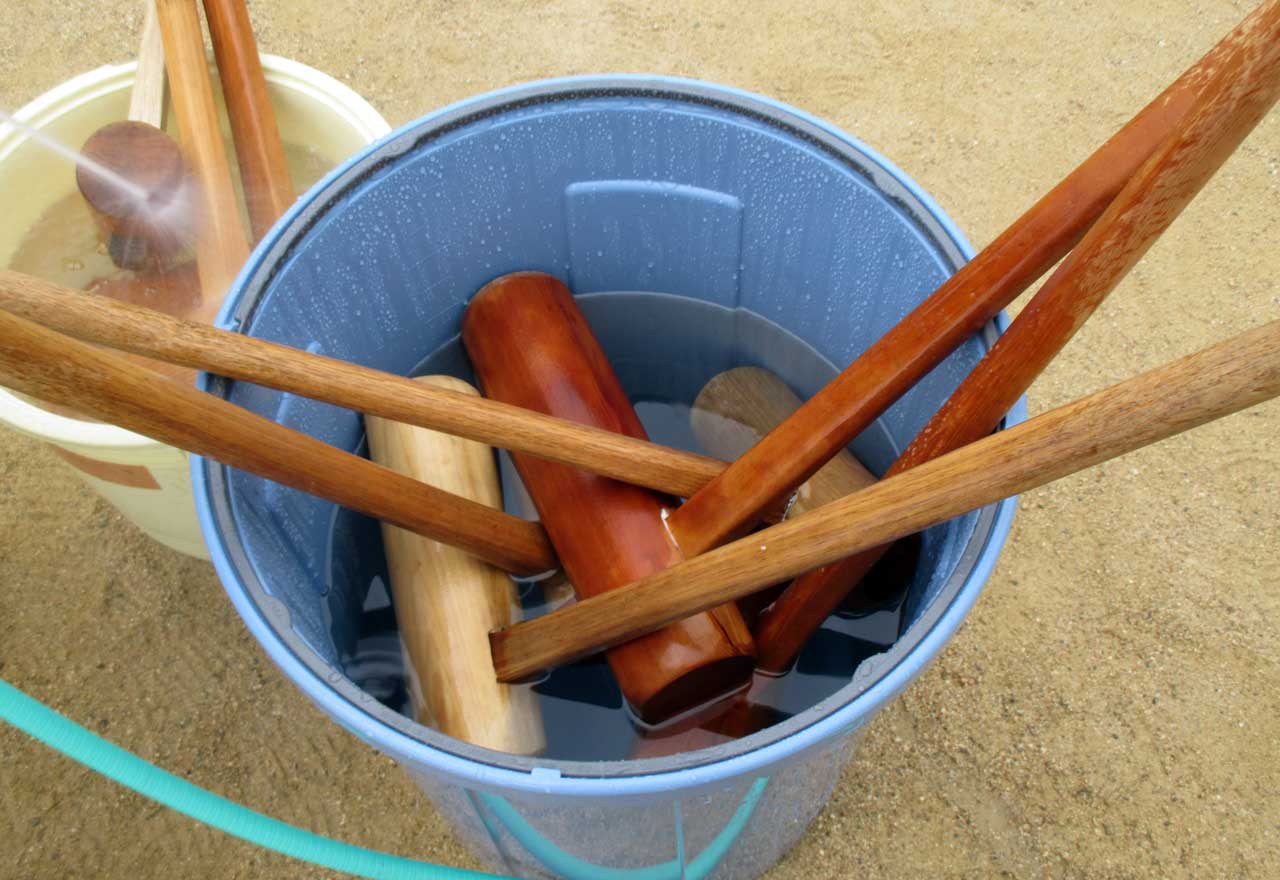
In the morning we prepare the tools – the usu, kine, and the steamers. The kine changes color after absorbing some water. These look ready to go!
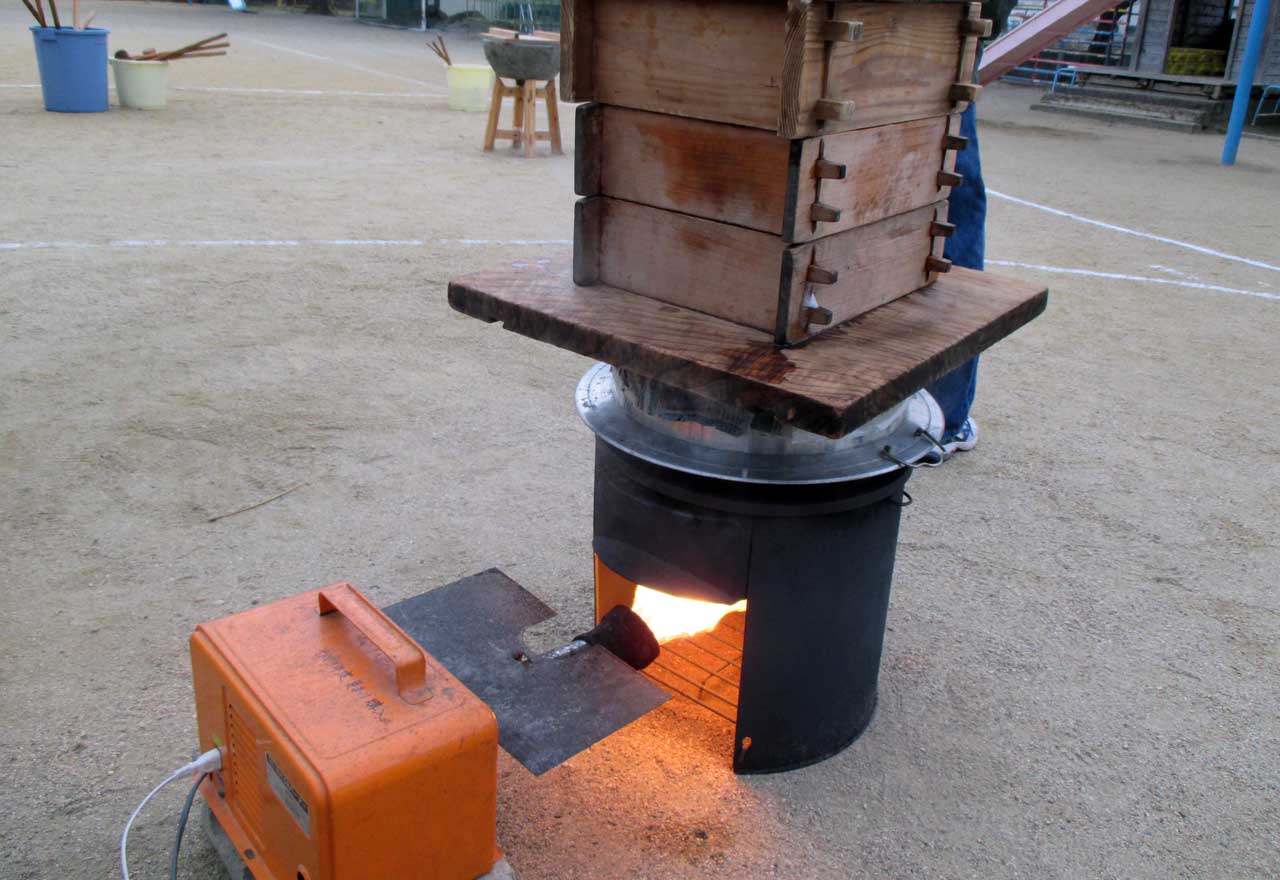
The torch blasts a flame under a pot of water that steams the rice held in the wooden boxes above.

When the rice is soft enough, it's placed in the usu and gently massaged with the kine. Once that step is finished, we start swinging. At first I thought power was necessary, so I swung the hammer down with all my might. But this caused problems: rice flew out of the usu and the kine chipped, leaving splinters in the mochi. I changed my rhythm and let the hammer fall naturally after that.
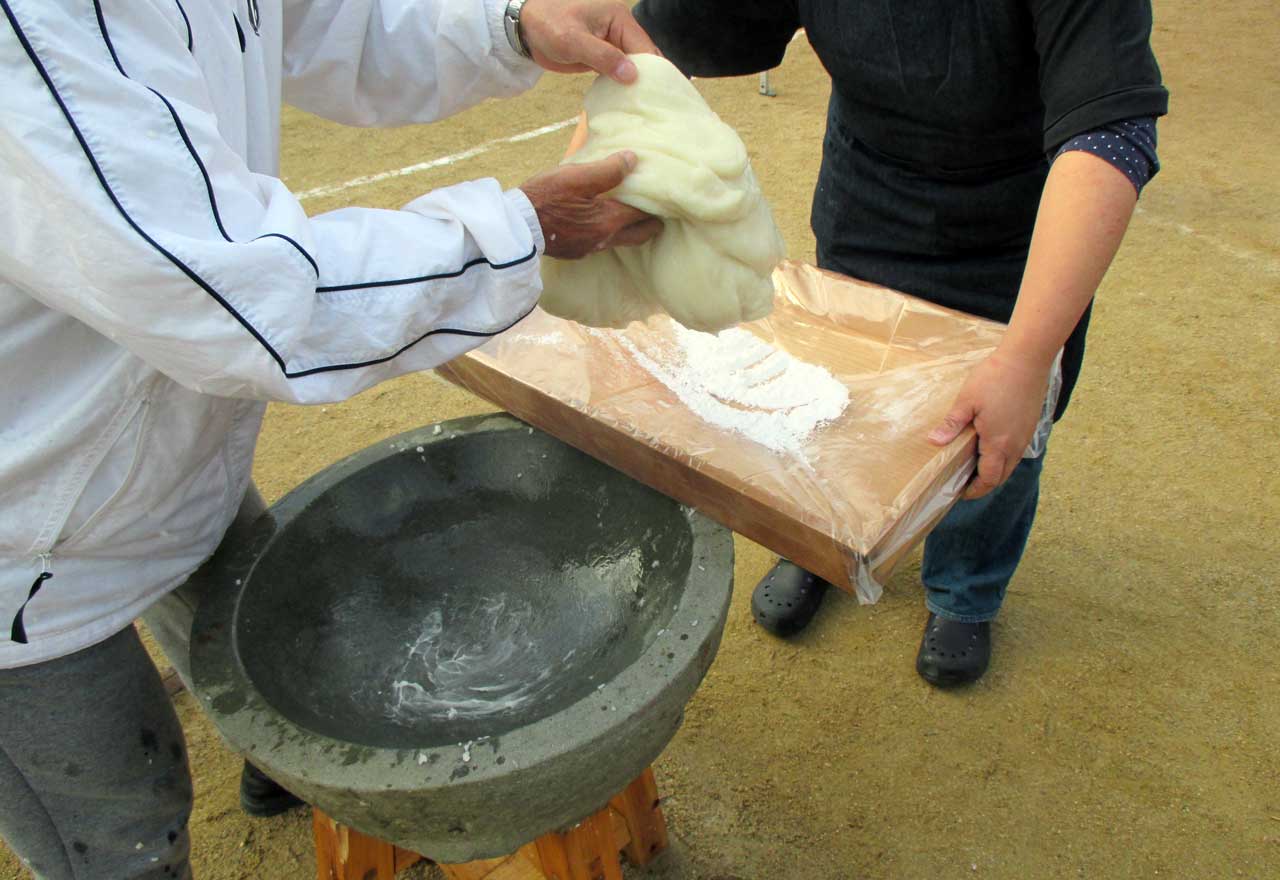
We broke into two groups, the outside group pounded the mochi while the inside group added the finishing touches, dividing mochi into single servings and adding anko or kinako.
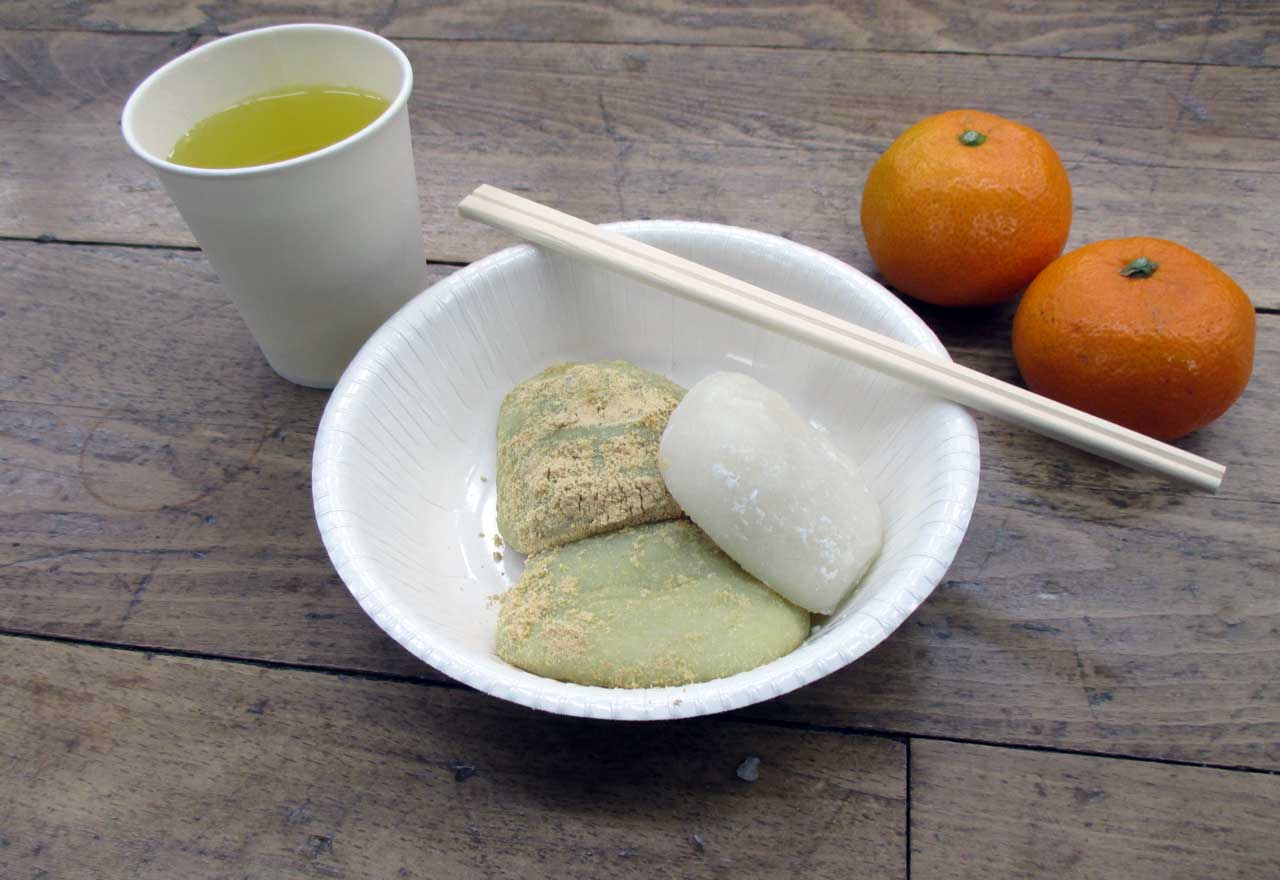
After all the rice was pounded and the mochi divided, we each got a plate of mochi, green tea, and a mikan: a satisfying end to a morning of hard work. Itadakimasu!
Mochi Recipes

If you gather a large group of people, a traditional mochi party is the most fun way to go.
By now your mouth is probably watering. But if you don't live in Japan, mochi can be hard to come by. Even if you live in Japan, you might not have the tools or experience to make mochi. Don't worry, I've got you covered. In addition to the traditional approach, I've laid some easy ways to make mochi at home.
The Traditional Japanese Mochi Recipe
The traditional approach, as I described above, requires careful preparation and tools. But if you gather a large group of people, a traditional mochi party is the best, most fun way to go. Here is the traditional recipe for mochi, written out step-by-step with easy to follow instructions:
The night before mochitsuki:
- Wash rice.
- Soak rice in water at a 2:1 ratio (2 parts water : 1 part rice).
- Wash and soak usu and kine.
The day of mochitsuki:
- Steam the rice until soft (10L of rice for 30 minutes)
- Check the rice with a chopstick. If the chopstick cuts through a grain of rice cleanly, the rice is ready.
- Soak mallets in cold water.
- Heat the usu with warm water, until it's warm to the touch
- Once the rice is ready, dry the usu.
- Put rice into the usu, enough to fill it halfway.
- Massage the rice with the kine until the rice loses its shape.
- Pound the rice with the kine, at first gently then increase the power. Gravity provides the necessary force. Aim for the middle and be careful not to chip the kine.
- Occasionally, wet hands and flip the ball of rice over. If there are enough people, designate one person for the job.
- When the rice is evenly pounded, it's done!
- Cut the mochi into small (palm-sized) pieces, add your favorite fillings, and roll them into balls.
- Lastly, roll the mochi balls in starch powder and enjoy or store for later.
Rice Cooker Method
You may not have an usu or kine on hand to make mochi the traditional way. But don't despair! Here's a simple recipe you can use to make mochi at home, using a rice cooker and rolling pin. Easy-peasy.
- Wash rice well.
- Add rice and water in the rice cooker at a 1:1 ratio.
- Let sit for 10 minutes.
- Start the rice cooker.
- Soak the rolling pin in salty water.
- When the rice is cooked, put it in a sturdy bowl and massage the rice with the rolling pin, until it loses its shape.
- Dip the rolling pin into water as needed to prevent sticking.
- Once the rice forms one solid mass, it's done!
- Cut the mochi into small (palm-sized) pieces, add your favorite fillings, and roll them into balls.
- Lastly, roll the mochi balls in starch powder and enjoy or store for later.
Electric Mochi Maker
If you can't live without a constant supply of sticky ricey goodness, an electric mochi maker might be a worthwhile purchase.
No recipe here. Just buy an electric mochi maker and throw the rice in. Done and done.
Storage
Although mochi is usually enjoyed fresh, you can freeze the surplus for later use. I've been told that they can last frozen about a year (any longer and they start to taste like the freezer). So mochi made around the New Year, can be enjoyed all year long. Refrigerated, it lasts a couple of weeks at best, while room temperature cuts its lifespan down to a few days. I learned this the hard way when my unfrozen mochi started growing hair — not an appetizing look.
A Little Disclaimer (Mochi Might Kill You)
I can't give you a bunch of recipes without revealing a dark secret: Mochi causes several deaths every year.
How does this happen? Mochi's stretchy consistency is a choking hazard. The large, gooey chunks can get lodged in your throats. Most fatalities occur among the elderly, but we should all use caution when eating our sticky rice treats. And the next time New Year's rolls around, keep your eyes on the news in Japan and you're bound to see a couple stories covering how many mochi deaths occured over the holidays.
Best Places to Get Mochi in Japan
Ichinoseki is known across Japan as mochi mecca.
Making your own mochi is all well and good, but for those looking for the optimal, artisanal variety should visit some of Japan's most renowned restaurants. Here are the absolute best places to buy mochi during your trip to Japan.
Tokyo
Mochi and Japanese Tea Cafe Gekko (お餅と日本茶の喫茶 月光) has authentic, fresh Japanese rice cakes made daily. Each batch is pounded over 300 times to ensure the finest consistency. Enjoy any (or all) of the six offerings including a specialty called karami mochi, made with ground daikon radish.
- Address: 3 Chome-7-18 Negishi, Taito, Tokyo prefecture 110-0003, Japan
- Website: Mochi and Japanese Tea Cafe Gekko
- Telephone: (+81) 03-5849-4569
- Hours:
- Mon – Fri (besides Wed): 12:00 – 19:30
- Wed: Closed
- Sat – Sun & Holidays: 12:30 – 19:00
Kinozen (紀の善) is a restaurant started in 1948, famous for sweets and mochi dishes. Mochi fans with a sweet tooth should try their fall/winter exclusive kurumi shiruko, which is mochi in walnut soup.
- Address: 1-12 Kagurazaka, Shinjuku, Tokyo prefecture 162-0825, Japan
- Website: Kinozen
- Telephone: (+81) 03-3269-2920
- Hours:
- Mon: Closed
- Tue – Sat: 11:00 – 20:00
- Sun & Holidays: 11:30 – 18:00
Oiwake Dango Honpo (追分だんご本舗) has a wonderful dish called inaka shiruko, which uses mochi made from Yamagata prefecture rice in a red bean soup. It's gooey and fluffy.
- Address: 3-1-22 Shinjuku, Shinjuku, Tokyo prefecture 160-0022, Japan
- Website: Oiwake Dango Honpo
- Telephone: (+81) 03-3351-0101
- Hours:
- Mon – Fri: 11:00 – 19:00
- Sat – Sun & Holidays: 11:00 – 20:00
Nagoya
Sabo Mochitsukian (茶房もちつき庵) holds its mochi to such high standards, they stay closed on days when the staff feels the mochi isn't up to snuff. Like many Japanese cafes, Sabo Mochitsukian offers meal sets, but theirs include toast and mochi in red bean soup.
- Address: 2-804 Ōtsubo, Tenpaku, Nagoya, Aichi prefecture 468-0072, Japan
- Website: Sabo Mochitsukian
- Telephone: (+81) 052-834-2138
- Hours:
- Thu – Mon: 8:30 – 17:00
- Tue – Wed: Closed
- Sun: Open for breakfast and lunch
Osaka
Cafe Smile (植村米穀店) is run by a certified rice advisor, and offers a high quality mochi experience. Give their butter soy sauce mochi a try!
- Address: 17 Kurusu, Nose, Toyono District, Osaka Prefecture 563-0351
- Website: Cafe Smile
- Telephone: (+81) 72-734-0066
- Hours:
- Mon – Tue: Closed
- Wed – Sun: 8:30 – 18:00
Kyoto
Awamochidokoro Sawaya (粟餅所・澤屋 ) is a mochi cafe located near Kyoto's Kitano Tenmangu Shrine and makes its mochi with awa 粟 (foxtail millet) instead of sticky rice.
- Address: 838-7 Kamiyagawacho, Kamigyo, Kyoto, Kyoto Prefecture 602-8384, Japan
- Website: Awamochidokoro Sawaya
- Telephone: (+81) 075-461-4517
- Hours:
- Fri – Wed: 9:00 – 17:00 (Closed when sold out)
- Thu & 26th of every month: Closed
Mochi Cuisine Kitamura (もち料理 きた村) is a tad expensive at ¥12,000 – ¥16,000 for dinner. It offers the quintessential Kyoto mochi experience, with over 15 types, including tarako mochi, covered in cod eggs, and uni mochi, topped with sea urchin and seaweed.
- Address: 154 Tennocho, Shimogy, Kyoto, Kyoto Prefecture 600-8013, Japan
- Website: Mochi Cuisine Kitamura
- Telephone: (+81) 075-351-7871
- Hours:
- Mon – Sat: 7:00 – 23:00
- Sun: Closed
Ichinoseki
Ichinoseki city in Iwate prefecture is known across Japan as a mochi mecca. It has mochi history dating back to the Edo Period, and nearly 60 mochi-specific celebrations per year. Not surprisingly, this city eats more mochi than any other place in the country.
The mochi fanatic will have a lot to love (and eat) in Ichinoseki thanks to the exclusive dishes served there. For example, Fusube is a dish made with grilled loach and ground burdock root, seasoned in soy sauce and chili peppers. Other specialties include mochi cheese fondue or mochi pizza.
Though you'll have a great mochi meal at most all restaurants in Ichinoseki, we recommend Sekinouchi (せきのうち). It's a sake and beer brewery with a great reputation. They offer various types of mochi bento boxes.
- Address: 5-42 Tamurachō, Ichinoseki-shi, Iwate-ken 021-0885, Japan
- Website: Sekinouchi
- Telephone: (+81) 0191-21-5566
- Hours:
- Mon – Sat: 11:30 – 14:00 & 17:00 – 21:00
- Sun & Holidays: 11:00 – 20:00
Mochi's Secret Ingedient

I've looked forward to every New Year's since moving to Japan, and a big reason is mochi parties. While pounding and eating mochi is loads of fun, above all else I prefer the social aspects of mochitsuki. When I join friends and meet new people, the mochi making process takes a backseat to joking, laughing, and interesting conversation. One old man, the local mochi master, told me everyone's positive energy is the magic ingredient that makes Japanese rice cakes delicious.
After five years of doing mochitsuki with him, I've yet to see his theory proven wrong.
